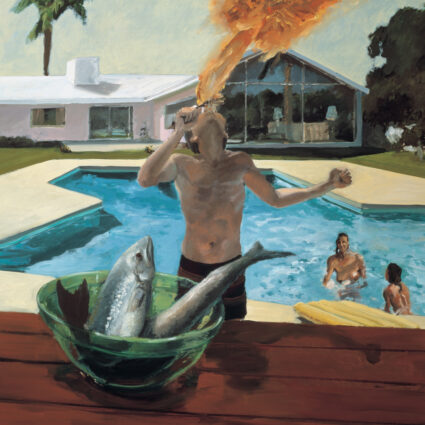Galisteo-based potter Robert King (Choctaw) discusses his collaboration and experimentation with clay in New Mexico’s high desert landscape.

In a garage-turned studio tucked into the rolling hills of the Galisteo Basin, you’ll find Robert King (Choctaw) working with wild clay. Tending to materials found in his backyard, King moves between geology, chemistry, medicine, teaching, and art. He wrestles with ideas of control and collaboration, expressing his individual experience of the high desert landscape.
1. Genesis
“People care about pottery here.”
In a previous life, King was living at home—the Choctaw Nation of Oklahoma—where he started a medical residency for his community. Well into the pandemic, he handed off the program to two alumni, began working in clay, and found a new home in Galisteo.
“Working with clay—and moving to New Mexico—was an important way for me to deal with the trauma associated with practicing medicine during COVID.”
King asks if it would be okay to work while we are talking.

2. Collaboration
“I need something with endless experimentation, creativity, and play. I try not to get too precious about any of the work because you’re never in control. You get brief moments of an illusion, but you have to be careful not to believe in those moments.”
Working on a large, sculptural vessel, he explains his process.
“Looking at this piece here, I know—or I hope—what it will look like. I’m going to put an additional black slip over the clay body, pull the black from behind, and add powdered red earth. But I could be completely wrong! I have to be okay with that—I have to embrace failure. I try to fail in a creative way because it sets you down paths that you can’t otherwise envision.”
“In what other medium do you make something ‘perfect,’ and then say, ‘I’m going to set it on fire at 2,000 degrees now?!’”
Clay teaches you what it wants to be.
“My hope is that people see some of themselves in the work—the imperfections, the fissures, the scars, the roughness, the smoothness, the beauty.”

3. Imperfection
What do you think clay has taught you?
“There have been many times in my life where I’ve tried to exert control over a situation, but clay has really helped me let go—it has become a part of my existence to adapt. As humans, we want to hold onto things. We think that we can’t go on after something happens for whatever reason.”
King points to a stone wall adjacent to the garage studio. “That little wall is my wall of shame. It is full of things that didn’t turn out how I wanted them to, but I’m fine. I continue to make pots.”
4. Experience
“I’ve taught pottery for a while now. I’ve had students complain because I don’t have a blackboard. Instead, we sit down and we make pottery together. Clay is so intertwined with the human experience that when people sit down, they already know what they’re doing. But problems arise, stuff happens. We troubleshoot together. I’m trying to help other people see this beauty.”
In the same way that clay is a teacher, landscape is also a teacher.
“I don’t want people to think that I’m trying to show them what New Mexico looks like. Instead, I’m trying to show them what my world looks like. My experience of this place is embodied by the work. I’m only translating what I see around me.”

5. Embrace
I ask about the award he won at this year’s Santa Fe Indian Market.
“I’m so glad you said that because it means it wasn’t just in my head. Did that happen?”
“It was so humbling—for my first year there—to have the support that I had. In addition to the blue ribbon, I loved chatting with folks, hearing that my work moved them in some way. I think people can see themselves in clay. Occasionally, people have visceral reactions, as if they passed a mirror and wanted to stop and look at themselves.”
“Living out here, working alone in my garage all winter, I sometimes question why I do this. You start to feel a little insane. On the other hand, there were some days where I felt as though it will matter, to someone, somewhere, someday. The work finds the right people.”
“Even though I am working with the commonly used materials of this region—volcanic stone, ash, sand, and wild clay—the aesthetic is divergent. This summer, I felt really affirmed. My work was appreciated, even though it was a little bit different.”

6. Pull
What motivates you to keep making pottery?
“It’s hard to speak through ceramics without being figurative. I love the challenge of it. I love the experimentation, and it always leaves me excited for tomorrow.”
“Clay doesn’t push me, it pulls me. The hope imbued in the medium pulls me to better understand this place, these materials, and how to speak. I feel like I’m just now learning how, and I’m excited for where that takes me. I think I have some things I’d like to tell the world.”
7. Fear
A few days later, King sends me a photograph of the piece he was working on during our conversation. He titles it, there is fear there, yes.
“Clay is perfect. It fits my mind. Feels like something I can do for a little while.”







